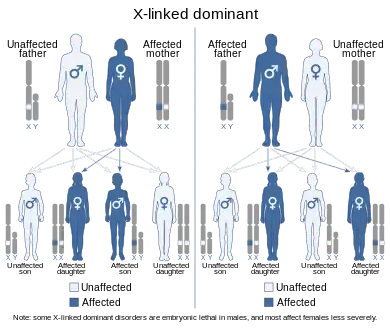X連鎖顯性遺傳
X連鎖顯性遺傳(X-linked dominant inheritance、X-linked dominance), 是遺傳的一種模式,顯性基因在X染色體攜帶。 作為一種遺傳模式,不如X連鎖隱性遺傳類型常見。在醫學上,X連鎖顯性遺傳是指導致遺傳疾病基因位於X染色體,從父母那裡遺傳時,僅等位基因一個拷貝就足以引起這種疾病。在這種情況下,基因表達X連鎖顯性等位基因的人將表現出這種疾病並被認為受到影響。
X-linked dominant traits do not necessarily affect males more than females (unlike X-linked recessive traits). The exact pattern of inheritance varies, depending on whether the father or the mother has the trait of interest. All fathers that are affected by an X-linked dominant disorder will have affected daughters but not affected sons. However, if the mother is also affected then sons will have a chance of being affected, depending on whether a dominant or recessive X chromosome is passed on. When the son is affected, the mother will always be affected. Some X-linked dominant conditions are embryonic lethal in males, making them appear to only occur in females.
遺傳學
As the X chromosome is one of the sex chromosomes (the other being the Y chromosome), X-linked inheritance is determined by the sex of the parent carrying a specific gene and can often seem complex. This is due to the fact that, typically, females have two copies of the X-chromosome, while males have only one copy. The difference between dominant and recessive inheritance patterns also plays a role in determining the chances of a child inheriting an X-linked disorder from their parentage.
Males can only get an X chromosome from their mother whilst females get an X chromosome from both parents. As a result, females tend to show higher prevalence of X-linked dominant disorders because they have more of a chance to inherit a faulty X chromosome.
Inheritance
In X-linked dominant inheritance, when the mother alone is the carrier of a mutated, or defective gene associated with a disease or disorder; she herself will have the disorder. Her children will inherit the disorder as follows:
- Of her daughters and sons: 50% will have the disorder, 50% will be completely unaffected. Children of either sex have an even chance of receiving either of their mother's two X chromosomes, one of which contains the defective gene in question.
When the father alone is the carrier of a defective gene associated with a disease or disorder, he too will have the disorder. His children will inherit the disorder as follows:
- Of his daughters: 100% will have the disorder, since all of his daughters will receive one copy of his single X chromosome.
- Of his sons: none will have the disorder; sons do not receive an X chromosome from their father.
If both parents were carriers of a defective gene associated with a disease or disorder, they would both have the disorder. Their children would inherit the disorder as follows:
- Of their daughters: 100% will have the disorder, since all of the daughters will receive a copy of their father's X chromosome.
- Of the sons: 50% will have the disorder, 50% will be completely unaffected. Sons have an equal chance of receiving either of their mother's X chromosomes.
In such a case, where both parents carry and thus are affected by an X-linked dominant disorder, the chance of a daughter receiving two copies of the X chromosome with the defective gene is 50%, since daughters receive one copy of the X chromosome from both parents. Were this to occur with an X-linked dominant disorder, that daughter would likely experience a more severe form.
Some X-linked dominant conditions such as Aicardi syndrome are fatal to boys; therefore only girls with these conditions survive, or boys with Klinefelter's syndrome (and hence have more than one X chromosome).
A few scholars have suggested discontinuing the use of the terms dominant and recessive when referring to X-linked inheritance, stating that the highly variable penetrance of X-linked traits in females as a result of mechanisms such as skewed X-inactivation or somatic mosaicism is difficult to reconcile with standard definitions of dominance and recessiveness.[1]
List of dominant X-linked diseases
参见
- Sex linkage
- X-linked recessive inheritance

參考
- Dobyns WB, Filauro A, Tomson BN, Chan AS, Ho AW, Ting NT, Oosterwijk JC, Ober C. . American Journal of Medical Genetics. Part A. August 2004, 129A (2): 136–43. PMID 15316978. doi:10.1002/ajmg.a.30123.
- Jais JP, Knebelmann B, Giatras I, De Marchi M, Rizzoni G, Renieri A, et al. . Journal of the American Society of Nephrology. October 2003, 14 (10): 2603–10. PMID 14514738. doi:10.1097/01.ASN.0000090034.71205.74
 .
. - Ngan V. . DermNet NZ. 2005 [2022-12-28]. (原始内容存档于2016-07-07).
- Incontinentia Pigmenti 於 eMedicine
- Dalal AB, Sarkar A, Priya TP, Nandineni MR. . American Journal of Medical Genetics. Part A. August 2010, 152A (8): 2057–60. PMID 20635354. doi:10.1002/ajmg.a.33505.
- Seager MJ, Whatley SD, Anstey AV, Millard TP. . Clinical and Experimental Dermatology. January 2014, 39 (1): 35–7. PMID 24131146. doi:10.1111/ced.12202.